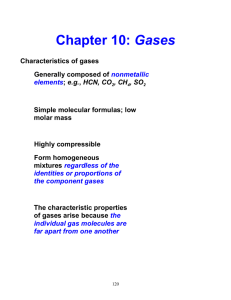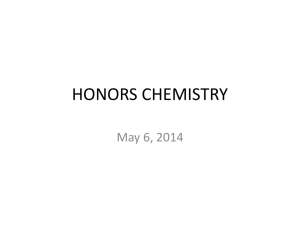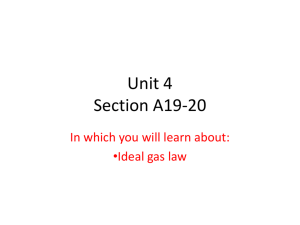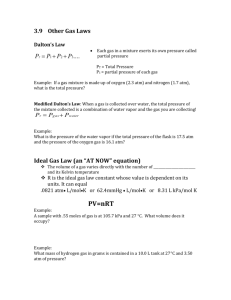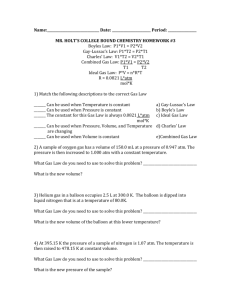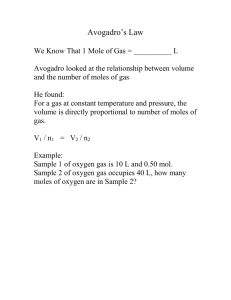Gas Law Intro Reading
advertisement
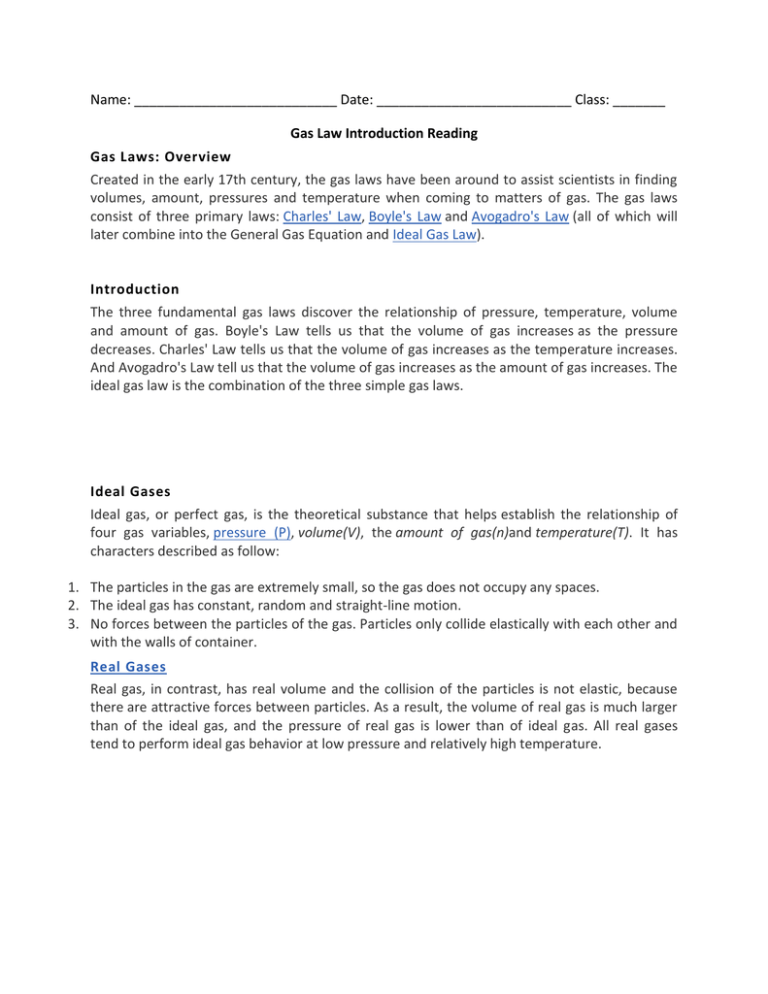
Name: ___________________________ Date: __________________________ Class: _______
Gas Law Introduction Reading
Gas Laws: Overview
Created in the early 17th century, the gas laws have been around to assist scientists in finding
volumes, amount, pressures and temperature when coming to matters of gas. The gas laws
consist of three primary laws: Charles' Law, Boyle's Law and Avogadro's Law (all of which will
later combine into the General Gas Equation and Ideal Gas Law).
Introduction
The three fundamental gas laws discover the relationship of pressure, temperature, volume
and amount of gas. Boyle's Law tells us that the volume of gas increases as the pressure
decreases. Charles' Law tells us that the volume of gas increases as the temperature increases.
And Avogadro's Law tell us that the volume of gas increases as the amount of gas increases. The
ideal gas law is the combination of the three simple gas laws.
Ideal Gases
Ideal gas, or perfect gas, is the theoretical substance that helps establish the relationship of
four gas variables, pressure (P), volume(V), the amount of gas(n)and temperature(T). It has
characters described as follow:
1. The particles in the gas are extremely small, so the gas does not occupy any spaces.
2. The ideal gas has constant, random and straight-line motion.
3. No forces between the particles of the gas. Particles only collide elastically with each other and
with the walls of container.
Real Gases
Real gas, in contrast, has real volume and the collision of the particles is not elastic, because
there are attractive forces between particles. As a result, the volume of real gas is much larger
than of the ideal gas, and the pressure of real gas is lower than of ideal gas. All real gases
tend to perform ideal gas behavior at low pressure and relatively high temperature.
Boyle's Law
In 1662, Robert Boyle discovered the correlation between Pressure (P)and Volume
(V) (assuming Temperature(T) and Amount of Gas(n)remain constant):
.
Pressure
is
inversely
proportional
to
Volume
Another form of the equation (assuming there are 2 sets of conditions, and setting both
constants to eachother) that might help solve problems is:
P1V1= P2V2
Example 1.1
A 17.50mL sample of gas is at 4.500 atm. What will be the volume if the pressure becomes 1.500 atm, with a f
gas and temperature?
SOLUTION
V2=P1⋅ V1P2
=4.500atm⋅17.50mL1.500atm
= 52.50mL
Charles' Law
In
1787,
French
physicists
Jacques
Charles,
discovered
the
correlation
between Temperature(T) and Volume(V) (assuming Pressure (P)and Amount of Gas(n) remain
constant):
. Volume is directly proportional to Temperature
Another form of the equation (assuming there are 2 sets of conditions, and setting both
constants to eachother) that might help solve problems is:
V1T1= V2T2
Example 1.2
A sample of Carbon dioxide in a pump has volume of 20.5 mL and it is at 40.0 oC. When the amount of gas and
constant, find the new volume of Carbon dioxide in the pump if temperature is increased to 65.0 oC.
SOUTION
V2=V1⋅T2T1
=20.5mL⋅(60+273.15K)40+273.15K
= 22.1mL
Avogadro's Law
In 1811, Amedeo Avogadro fixed Gay-Lussac's issue in finding the correlation between
the Amount
of
gas(n) and Volume(V) (assumingTemperature(T) and Pressure(P) remain
constant):
Volume(V) is directly proportional to the Amount of gas(n)
Another form of the equation (assuming there are 2 sets of conditions, and setting both
constants to eachother) that might help solve problems is:
P1n1 =P2n2
Example 1.3
A 3.80 g of oxygen gas in a pump has volume of 150 mL. constant temperature and pressure. If 1.20g of oxygen
gas is added into the pump. What will be the new volume of oxygen gas in the pump if temperature and
pressure held constant?
SOLUTION
V1=150 mL
n1=m1Moxygengas
n2=m2Moxygengas
V2=V1⋅n2n1
\boldsymbol{= \dfrac{150mL\centerdot \dfrac{5.00g}{32.0g \centerdot mol^1} \dfrac{3.80g}{32.0g\centerdot mol^-1}}
= 197ml
Ideal Gas Law
The ideal gas law is the combination of the three simple gas laws. By setting all three laws
directly or inversely proportional to Volume, you get:
PV=nRT
where P= the absolute pressure of ideal gas
V= the volume of ideal gas
n = the amount of gas
T = the absolute temperature
R = the gas constant
Here, R is the called the gas constant. The value of R is determined by experimental results. Its
numerical value changes with units.
R
=
gas
constant
=
-1
= 0.082057 L · atm·K · mol-1
8.3145
Joules
·
mol-1 ·
K-1 (SI
Unit)
Example 1.4
At 655mm Hg and 25.0oC, a sample of Chlorine gas has volume of 750mL. How many moles of Chlorine gas a
this condition?
P=655mm Hg
T=25+273.15K
V=750mL=0.75L
n=?
SOLUTION
n=PVRT
=655mmHg⋅1atm760mmHg⋅0.75L0.082057L⋅atm⋅mol−1⋅K−1⋅(25+273.15K)
=0.026mol
Evaluation of the Gas Constant, R
You can get the numerical value of gas constant, R, from the ideal gas equation, PV=nRT. At
standard temperature and pressure, where temperature is 0 oC, or 273.15 K, pressure is at
1 atm, and with a volume of 22.4140L,
R=PVRT
1atm⋅22.4140L1mol⋅273.15K
=0.082057L⋅atm⋅mol−1K−1
R=PVRT
=1atm⋅2.24140⋅10−2m31mol⋅273.15K
=8.3145m3Pa⋅mol−1⋅K−1
Standard Conditions
If in any of the laws, a variable is not give, assume that it is given. For constant temperature,
pressure and amount:
1. Absolute Zero (Kelvin): 0 K = -273.15 oC
T(K) = T(oC) + 273.15 (unit of the temperature must be Kelvin)
2. Pressure: 1 Atmosphere (760 mmHg)
3. Amount: 1 mol = 22.4 Liter of gas
4. In the Ideal Gas Law, the gas constant:
R
=
8.3145
Joules
·
= 0.082057 L · atm·K-1 · mol-1
mol-1 ·
K-1
